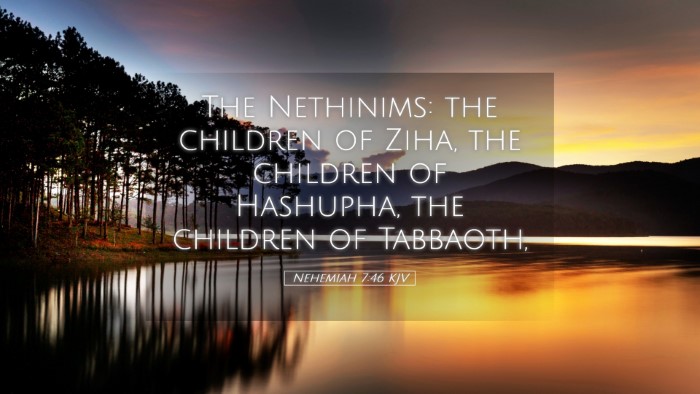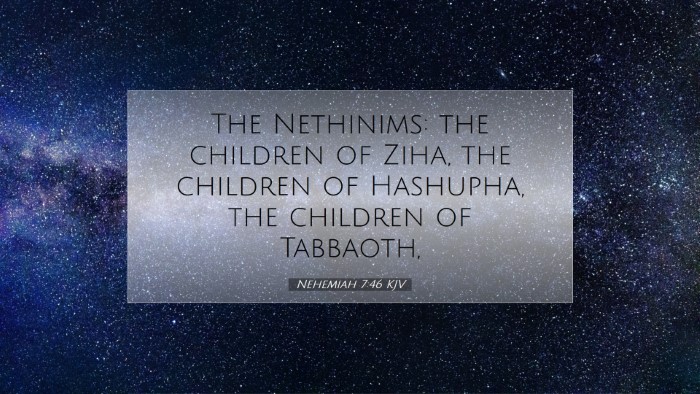Commentary on Nehemiah 7:46
Nehemiah 7:46 states: “The sons of the gatekeepers: the sons of Shallum, the sons of Ater, the sons of Talmon, the sons of Akkub, the sons of Hatita, the sons of Shobai, in all 138.” This verse lists the families of gatekeepers who served in the restoration of the Jerusalem’s walls and the re-establishment of its community after the Babylonian exile.
Overview and Context
In the broader context of Nehemiah, this verse fits into the narrative of rebuilding the walls of Jerusalem. After the exile, Nehemiah returned to Jerusalem to address various issues facing the Jewish people, including the boycotting of resources needed for life and worship. The listing of families and groups, especially gatekeepers, holds significant importance as it emphasizes organization and establishes a sense of restored order within the city.
Historical Significance
As noted by Matthew Henry in his commentary, the role of gatekeepers was crucial in ancient Israelite culture. They not only guarded physical entrances but also held a spiritual responsibility to protect the sanctity of the city and its people. The gatekeepers were often the first line of defense against both invaders and internal corruption.
The Importance of Inclusion
Albert Barnes emphasizes the importance of collective identity in this verse. By naming these families, Nehemiah acknowledges the contribution of each clan to the community's restoration. It reinforces the communal aspect of rebuilding and reestablishing their identity as a people of God, suggesting that everyone has a part to play in fulfilling God's work.
Theological Implications
Adam Clarke points toward the theological implications of leadership roles in the temple service. The gatekeepers were responsible for who could enter and exit God’s holy space, symbolizing broader themes of holiness, separation, and access to God. This has a larger implication for church leadership today, encouraging a view of leadership that emphasizes service and responsibility within church communities.
Leadership and Responsibility
The mention of gatekeepers signals a leadership structure within the post-exilic community. Those listed were entrusted with a sacred duty, indicating a model for pastoral leadership that balances authority with servitude. Leaders today can learn that their roles involve protecting the community and ensuring that increasingly diverse populations feel safe and welcome within the church.
Spiritual Warfare
Moreover, Matthew Henry describes gatekeeping as a metaphor for spiritual vigilance. Believers are called to guard their hearts against negative influences, much like how gatekeepers safeguard the city. Recognizing this, pastors and theologians can draw parallels in their teachings, preparing believers to be vigilant against the spiritual challenges they face.
Conclusion
In conclusion, Nehemiah 7:46 provides rich insights into the nature of community, leadership, and spiritual vigilance. Drawing from the wisdom of public domain commentaries, it is clear that the roles within the community, while seemingly simple, are filled with significance. These verses challenge pastors, students, and scholars alike to reflect on the importance of community within church life, the significance of each member’s contribution, and the need for discernment and vigilance in spiritual matters.
Reflection Questions
- How can we as a community ensure that each member feels valued and necessary?
- In what ways can we emulate the vigilance of gatekeepers in our spiritual lives?
- What lessons in leadership can we derive from the roles assigned in Nehemiah’s restoration efforts?


